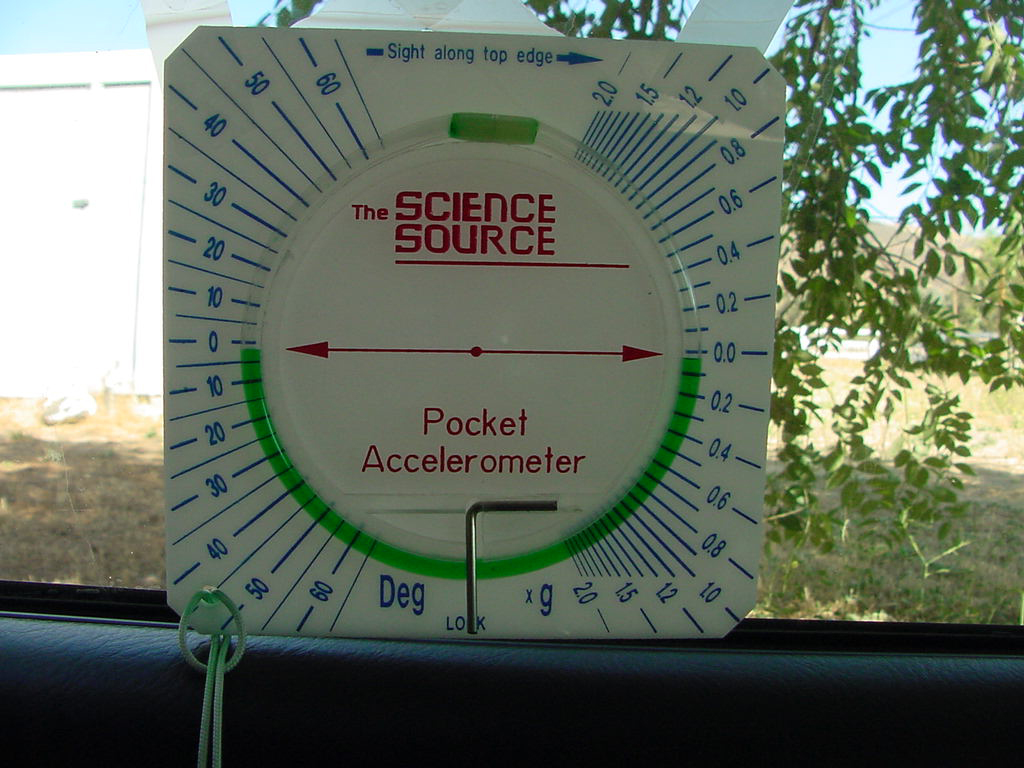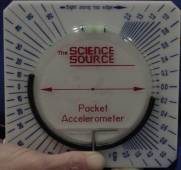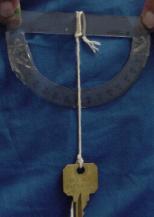Middle School Accelerometer Lab |
|||||||||||||||||||||||||||||||||||||||
|
Author(s): Peggy Klipfel LeDuff |
Demonstration Equipment -
Teacher's Guide |
||||||||||||||||||||||||||||||||||||||
|
Principles illustrated: 1. Linear Acceleration 2. Conversion of degree units (q) to acceleration units (A) in g’s using the formula A=tan(q) |
10o or .2g's of acceleration Direction of acceleration to right
45o of acceleration or 1g Direction of acceleration to left |
||||||||||||||||||||||||||||||||||||||
|
Standards addressed: Motion
|
|||||||||||||||||||||||||||||||||||||||
|
|
|
|
|
||||||||||||||||||||||||||||||||||||
|
Materials |
Explanation of principles involved |
||||||||||||||||||||||||||||||||||||||
|
1. Accelerometer |
Acceleration is the change in velocity over time and the accelerometer will allow the students to easily measure the acceleration changes in their car as they drive to school or on another errand. The tool works by measuring the degree of acceleration in degrees. The student then would use their knowledge of trigonometry to convert the degrees into gravitational acceleration (g’s) using the formula a=tan(q) where a is the acceleration in g’s and q is the degree measured with the accelerometer. |
||||||||||||||||||||||||||||||||||||||
|
|
|||||||||||||||||||||||||||||||||||||||
|
Procedure: 1. Take off clear tube and fill it half way with water, add food coloring
to color water for easy data reading, recap, put it back on the accelerometer
so that both ends of water are on the zero. |
|||||||||||||||||||||||||||||||||||||||
|
|
This
is the pocket accelerometer we will use today. The zero points are a mark of no acceleration. Positive forward acceleration is seen when
the liquid rises on the right side of the accelerometer, deceleration is
recorded when the liquid is below the 0.0 mark on the right hand side The
accelerometer should be held vertically with the arrows facing the direction
of motion To
convert degrees to g’s, use the formula a=tan(q)
Here is a video of what a decelerating car would show up like on the pocket accelerometer. Notice there is a -.2g deceleration.
Here is a short video showing a typical car ride, typical acceleration averaged about 2deg or 0.04g's, with deceleration a little sharper as the car needed to stop for cars in front of it, the deceleration was about 0.1g's. |
||||||||||||||||||||||||||||||||||||||
|
|
If you can’t buy a fancy pocket accelerometer, it is easy to make one with a protractor, string and a weight at the end of the string. With zero acceleration, the weight hangs vertically at the 90o mark. During acceleration, measure the angular deflection of the string. The greater the angle, the greater the acceleration. |
||||||||||||||||||||||||||||||||||||||
|
|
In this example, the acceleration is measured at 30o, using the conversion, the acceleration would be 0.58g’s. |
||||||||||||||||||||||||||||||||||||||
|
|
Use
this as your data table |
||||||||||||||||||||||||||||||||||||||
|
|
|
||||||||||||||||||||||||||||||||||||||
|
References & Links: http://www.phy.cmich.edu/people/andy/Physics110/Book/Chapters/Chapter6.htm
|
|||||||||||||||||||||||||||||||||||||||





